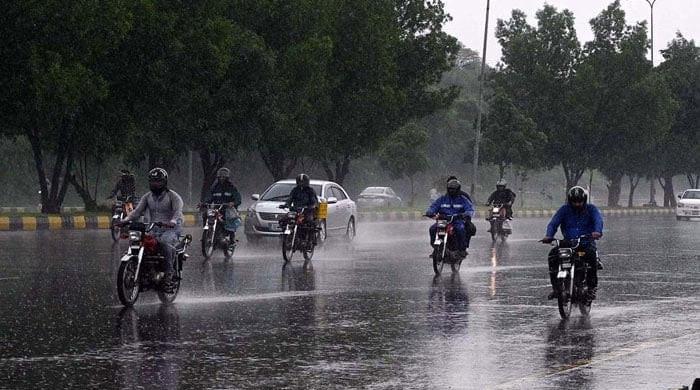Monsoon Rains Claim Over 110 Lives in Pakistan
Government figures released on Monday revealed that more than 110 individuals, including numerous children, have tragically lost their lives due to monsoon rains in Pakistan since their arrival in late June.
According to data from the National Disaster Management Authority (NDMA) spanning from June 26 to July 14, electrocution emerged as the primary cause of these fatalities, followed by devastating flash floods.
Tragically, in late June, at least 13 tourists were swept away and lost their lives while seeking refuge from raging flash floods on an elevated riverbank.
In its most recent report, the disaster agency conveyed that 111 individuals, encompassing 53 children, have perished, with the highest concentration of deaths occurring in Punjab, the nation’s most populous province.
The Pakistan Meteorological Department (PMD) has issued warnings of substantial rainfall expected from July 15 to 17, as a low-pressure area (LPA) currently situated over northwest Madhya Pradesh, India, is projected to impact Pakistan within the subsequent 24 to 72 hours.
The PMD communicated in a statement that, influenced by this weather system, potent monsoon currents are anticipated to penetrate the central and upper regions of the country from July 15 to 17.
“Additionally, a westerly wave is prevailing over the upper regions of the nation,” it was noted. In light of these meteorological circumstances:
- The weather authority has predicted exceptionally heavy rainfalls accompanied by rain-wind and thundershowers across sections of Kashmir, alongside localized heavy downpours in Gilgit-Baltistan from July 14 to 17, with intermittent breaks.
- It has also forecasted “very heavy to extremely heavy” rainfall in specific areas of Khyber Pakhtunkhwa from the night of July 14 to 17.
Rain-wind/thundershowers, along with dispersed heavy falls (occasionally very heavy), are anticipated in Kashmir (Neelum valley, Muzaffarabad, Rawalakot, Poonch, Hattian, Bagh, Haveli, Sudhanoti, Kotli, Bhimber, Mirpur) from the night of July 14 to 17.
Rain-wind/thunderstorms (accompanied by isolated heavy falls) are projected for Gilgit-Baltistan (Diamir, Astore, Ghizer, Skardu, Hunza, Gilgit, Ghanche, Shigar) from the night of July 14 to July 17, featuring occasional gaps.
Rain-wind and thundershowers, including scattered heavy falls (at times very heavy/extremely heavy), are expected in Dir, Chitral, Swat, Kohistan, Malakand, Shangla, Battagram, Buner, Kohat, Karak, Bannu, Tank, Lakki Marwat, Dera Ismail Khan, Bajaur, Mohmand, Khyber, Waziristan, Orakzai, Mansehra, Abbottabad, Haripur, Peshawar, Charsadda, Nowshera, Mardan, Swabi, Hangu, and Kurram from the night of July 14 to 17, with intermittent pauses.
Rain-wind/thundershowers, coupled with scattered heavy falls (at times very heavy/extremely heavy), are also anticipated in Islamabad/Rawalpindi, Murree, Galliyat, Attock, Chakwal, Jhelum, Mandi Bahauddin, Gujrat, Gujranwala, Hafizabad, Wazirabad, Lahore, Sheikhupura, Sialkot, Narowal, Sahiwal, Jhang, Toba Tek Singh, Nankana Sahib, Chiniot, Faisalabad, Okara, Kasur, Khushab, Sargodha, Bhakkar, Mianwali, Bahawalpur, Bahawalnagar, D.G. Khan, Multan, Khanewal, Lohdran, Muzaffargarh, Rajanpur, Rahimyar Khan, Kot Addu, and Layyah from the evening of July 14 to 17, with occasional gaps.
Rain-wind/thundershowers, featuring scattered heavy falls (at times very heavy), are predicted in the northeastern and southern regions (Quetta, Zhob, Qilla Saifullah, Qilla Abdullah, Ziarat, Sherani, Musakhel, Loralai, Sibbi, Bolan, Barkhan, Naseerabad, Kalat, Lasbella, Khuzdar, Awaran, Jaffarabad, Dera Bugti, and Kohlu) from July 14 to 16.
Rain-wind/thundershowers are projected in Tharparkar, Mirpur Khas, Sanghar, Sukkur, Larkana, Dadu, Jacobabad, Khairpur, and Shaheed Benazirabad from July 14 to 16, with occasional gaps. Light rainfall is also anticipated in Karachi.
Advising relevant authorities to maintain heightened vigilance, the PMD cautioned that the heavy downpours could lead to flash floods in local streams and nullahs, as well as hill torrents.
These intense rain events may also instigate urban flooding in low-lying zones and road closures in susceptible hilly terrains owing to landslides and mudslides.
The public, travelers, and tourists are urged to refrain from unnecessary exposure in vulnerable locales to avert potential adverse situations and remain informed about prevailing weather conditions.
The monsoon season contributes 70 to 80% of South Asia’s total annual rainfall, initiating in early June in India and late June in Pakistan, and persisting until September.
These annual rains are crucial for agricultural activities, food security, and the sustenance of millions of farmers.
However, they also bring about flooding, landslides, and building collapses.
South Asia is experiencing rising temperatures and, in recent times, has witnessed shifting weather patterns; however, scientists lack clarity on the precise manner in which a warming planet is influencing the highly intricate monsoon.
Pakistan stands as one of the world’s most susceptible nations to the repercussions of climate change, and its 240 million inhabitants are increasingly encountering extreme weather occurrences.
In 2022, unprecedented monsoon floods submerged one-third of Pakistan, resulting in 1,700 fatalities, with certain regions still grappling with the aftermath.
Earlier in May, severe storms, including intense hailstorms, caused at least 32 deaths.



Comments (0)
No comments yet. Be the first to comment!
Leave a Comment